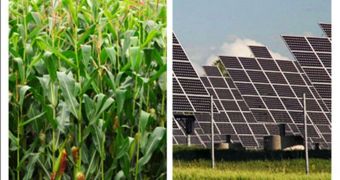Ever since solar cells appeared, experts have always wondered about which method of harvesting the Sun's energy is the most efficient. Many say that photosynthesis – nature's way of doing things is the best – while others argue that photovoltaic cells are more efficient.
In a study to be published today, May 13, in the top journal Science, a team of experts will try to settle this matter once and for all. The thing is, scientists admit, that conducting a comparison between the two is extremely complex.
The methods entail entirely different mechanisms of taking advantage of the Sun's energy, explains the director of the Arizona State University (ASU) Center for Bioenergy and Photosynthesis, Thomas Moore. He is also a coauthor of the Science report.
“In order to make meaningful comparisons between photosynthesis and photovoltaic technology, we considered photovoltaic driven water electrolysis to yield hydrogen using existing technology as an example of artificial photosynthesis,” he explains.
The expert adds that photosynthesis provides stored chemical potential, whereas photovoltaic technologies provide instantaneous electrical power. This is a very important difference, he underlines.
“The hydrogen produced by the artificial system is thermodynamically equivalent to the sugar produced by photosynthesis,” Moore goes on to say.
“The take-home from this point is that the artificial system out performs the natural one, but on the basis of potential for efficient solar energy conversion as measured by the land area required for a given energy output, both technological and biological processes could in principle offer similar outcomes,” he adds.
At this point, the international scientific community is conducting a wide series of investigations into detecting methods of improving photosynthesis. Like any evolutionary adaptation, it too is imperfect.
Physicists and chemists have already been able to identify the areas in which photosynthesis is not as efficient as it could be, and now plan to develop methods of boosting the process' efficiency level.
“These improvements to photosynthesis go beyond the incremental steps practiced since agriculture began thousands of years ago,” Moore says. He is also a Regents’ Professor in the ASU College of Liberal Arts and Sciences Department of Chemistry and Biochemistry.
“At the end we allude to the use of synthetic biology to bring the knowledge and experience from fundamental studies in physics and artificial photosynthesis to photosynthesis in a combination of biology with technology to meet human energy needs,” he concludes.

 14 DAY TRIAL //
14 DAY TRIAL //